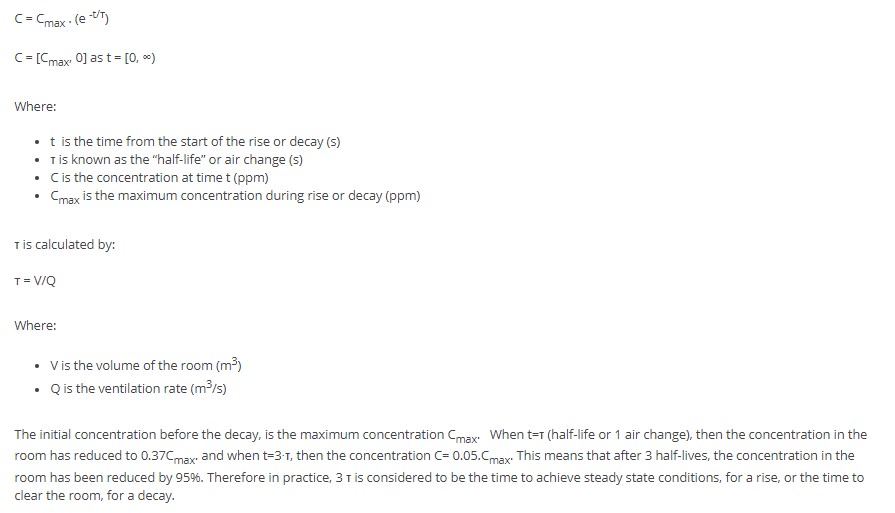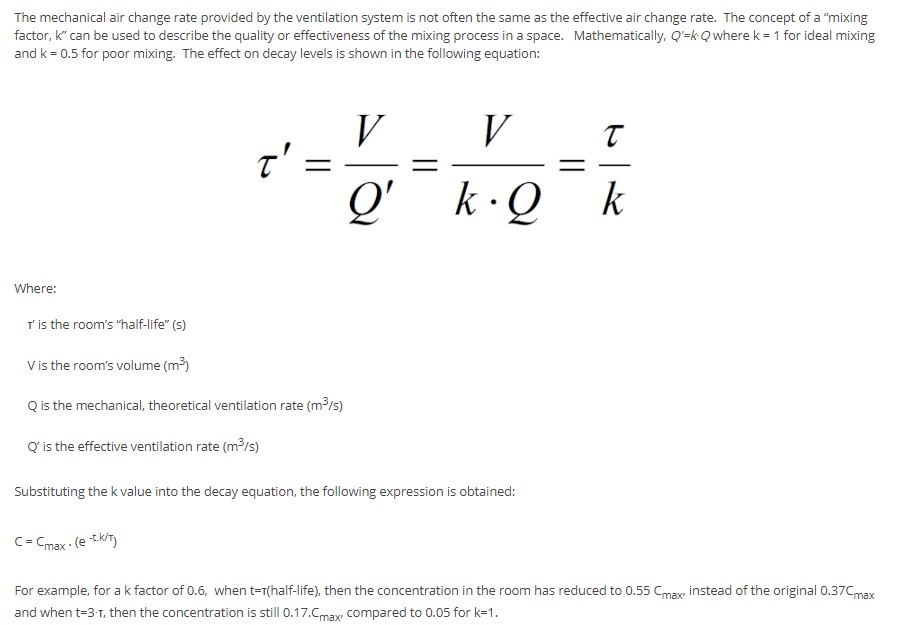Effective ventilation in buildings
Contents |
[edit] Introduction
The World Health Organisation has published information about the airborne transmission of COVID-19. This information further emphasises the importance of having good, effective ventilation in a building.
[edit] Air change rates
Ensuring correct air change rates in an occupied space has always been an important design consideration - one perhaps perceived as only being critical in healthcare settings. Given our ‘new normal’, the emphasis on correct air change rates across all occupied settings is becoming crucial.
The air change rate (ACR) in a room is a function of the ventilation supply or extract flowrate (in l/s or m³/h) and a function of the volume of the room (m³). The resultant air change rate, normally expressed as air changes per hour (ACH) (h-1), gives us an indication of how many times per hour the ventilation system provides the room with new fresh air.
Ventilation is paramount to dilute the concentration of airborne contaminants and it is important to understand how contaminants are diluted, in order to establish procedures, i.e. time that has to pass between patients entering a room in a hospital.
[edit] Making calculations
By means of visualising the air change rate in a room, if we have an empty glass simulating our room - which is sitting under a tap acting as our ventilation system - and the tap is turned on the equivalent air change rate is a count of how many times the glass can be filled with water in a certain period of time. If some or all of the water misses the glass and goes directly down the drain, the air change rate is effectively reduced. As in the case of a ventilation system, consideration would also need to be given as to what the consequences may be if the tap water were contaminated.
If the source of contaminants is still in the room, the ventilation system will eventually provide a steady state concentration of contaminants, which is diluted if compared to the source. If there are (airborne) contaminants in the room, but the source has left (e.g. the patient has left the surgery) the ventilation system will purge the contaminants with every air change.
The decay of the concentration can be expressed by the equation:
 [Please click on the image to see the equation.]
[Please click on the image to see the equation.]
We do have to take into account the fact that the air supplied must be fresh, i.e. not recirculated and that the ventilation must be effective; fresh air must not be short circuited into the extract and it must reach everywhere in the room, to avoid areas of high contaminant concentration (stagnation).
 [Please click on the image to see the equation.]
[Please click on the image to see the equation.]
This means that it will take longer to purge the contaminant from the room i.e. If the ACR of an isolation room is 10 ACH, for a k value of 0.6, the effective ventilation rate would be 6 ACH.
BSRIA has studied several hospital isolation rooms with dedicated ventilation. The k factor in those rooms, which were considered well-mixed, was k= 0.8, calculated using gas tracer methodologies.
This article originally appeared on the BSRIA website under the title, "New World Health Organisation information emphasises effective ventilation in buildings." It was published July 2020.
--BSRIA
[edit] Related articles on Designing Buildings
- Air change rates.
- Air filtration and clean Indoor air quality standards.
- Air tightness in buildings.
- At a glance - Indoor air quality.
- BSRIA articles on Designing Buildings Wiki.
- Ensuring good indoor air quality in buildings.
- HVAC balancing.
- HVAC industry defines post COVID-19 changes.
- Indoor air quality.
- Indoor air velocity.
- Let us evolve our buildings from being passive structures to interactive and reactive systems.
- Mechanical ventilation's role in improving indoor air quality.
- Timber and healthy interiors.
- Ventilation.
- Ventilation and control of COVID-19 transmission.
[edit] External resources
Featured articles and news
A change to adoptive architecture
Effects of global weather warming on architectural detailing, material choice and human interaction.
How big is the problem and what can we do to mitigate the effects?
Overheating guidance and tools for building designers
A number of cool guides to help with the heat.
The UK's Modern Industrial Strategy: A 10 year plan
Previous consultation criticism, current key elements and general support with some persisting reservations.
Building Safety Regulator reforms
New roles, new staff and a new fast track service pave the way for a single construction regulator.
Architectural Technologist CPDs and Communications
CIAT CPD… and how you can do it!
Cooling centres and cool spaces
Managing extreme heat in cities by directing the public to places for heat stress relief and water sources.
Winter gardens: A brief history and warm variations
Extending the season with glass in different forms and terms.
Restoring Great Yarmouth's Winter Gardens
Transforming one of the least sustainable constructions imaginable.
Construction Skills Mission Board launch sector drive
Newly formed government and industry collaboration set strategy for recruiting an additional 100,000 construction workers a year.
New Architects Code comes into effect in September 2025
ARB Architects Code of Conduct and Practice available with ongoing consultation regarding guidance.
Welsh Skills Body (Medr) launches ambitious plan
The new skills body brings together funding and regulation of tertiary education and research for the devolved nation.
Paul Gandy FCIOB announced as next CIOB President
Former Tilbury Douglas CEO takes helm.
UK Infrastructure: A 10 Year Strategy. In brief with reactions
With the National Infrastructure and Service Transformation Authority (NISTA).
Ebenezer Howard: inventor of the garden city. Book review.
Airtightness Topic Guide BSRIA TG 27/2025
Explaining the basics of airtightness, what it is, why it's important, when it's required and how it's carried out.























